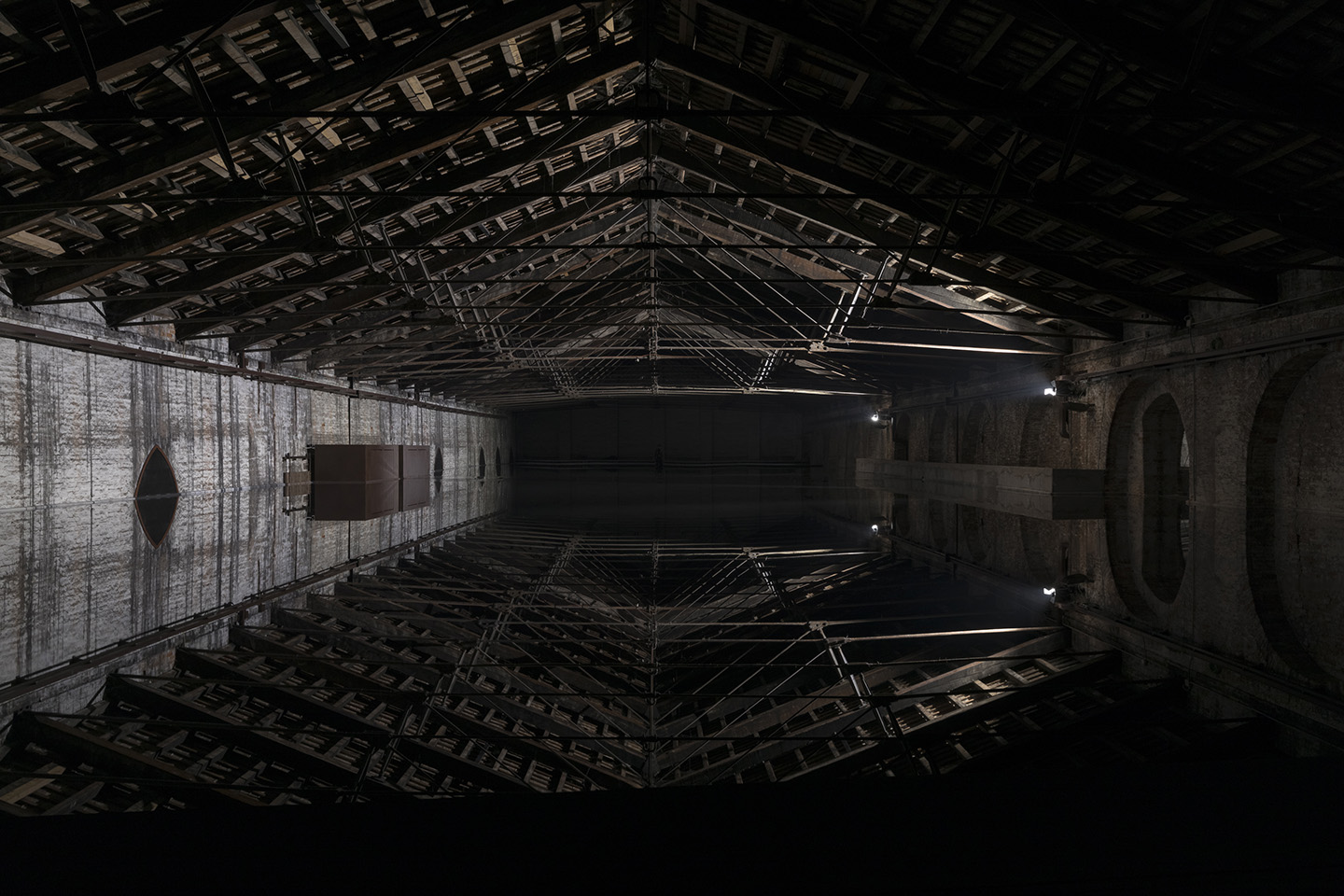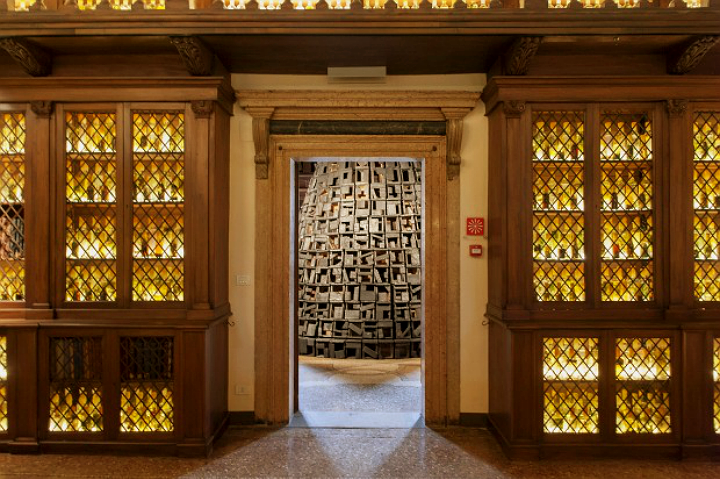Venice Biennale 2017: Instagram Blockbusters and Must-See Pavilions
By Henrique Menezes @henrique__menezes
"Faust" by German artist Anne Imhof has long hours of few-seconds-videos on Instagram. This fractioned narrative hides unutterable sensations: a prison-style fence surrounds the external area, leading to the strained experience even before the actual performance; the pavilion reverberates frightful echoes, imperceptible by microphones; the internal structure is times bigger and higher than the lens can reveal but the numerous visitors contribute to claustrophobia, just to point a few elements that an insider can describe.
This article focuses on the dialectic between internet blockbusters and immersive artworks that no picture can suggest. Describing synesthetic thrills by language — equally a laborious intention —, this essay tries to distinguish significant artistic manifestations in La Biennale di Venezia whose intrinsic constitution turns into uncapturable. It's the first text of a series covering the 57th Art Biennale and its collateral events: follow Contemporary Art Curator to read the next analyses.
VIVA ARTE VIVA, mediated by images
In 1935, Walter Benjamin wrote the famous “The Work of Art in the Age of Mechanical Reproduction” in which he investigates the impact of technical copies on modern artistic functions. Facing the popularization of photography, a central question emerges: even in the most perfect reproduction of an artwork is lacking its presence in time and space. This unique existence is called “aura”, referring to the uniqueness sense in the field of perception.
Decades (and uncountable references to this classic) helped to minimize the purism, and art market couldn’t survive without the reproduction — now used also as a marketing tool. Venice Biennale encourages the use of hashtags like #VivaArteViva and #BienalleArte2017 to promote the shows, which have become helpful thermometers of what impress the connoisseurs. At Girdigini, the attention as well as the flashes are multiplied in different angles to blockbuster works of the triad Bradford-Barlow-Bove, representing respectively US, GB and Switzerland pavilions. The Floating City’s landscape has another group of ready-made-hashtags: Lorenzo Quinn’s phantasmagorical hands, Damien Hirst’s “““treasures””” and an elegant golden obelisk of James Lee Byars.
Although, have you seen everything on Instagram? Here, are elected some honorable Venice Arte’s components with one certain: expect much more than a 2D experience can offer.
Sebastián Díaz Morales
Even if you scroll over thousands of posts about the Biennial, you surprisingly won’t find registers of “Suspension”, a breathtaking installation by Argentinian artist Sebastián Díaz Morales.
Part of the main exhibition, composing the “Pavilion of Joys and Fears”, the work arouses an atmosphere of entire disconnection and evokes antithetic senses — as an answer to the curatorial chapter’s title. Once you enter the room, a red neon line cutting the ceiling adds a baffling component to the music, and an immense wall receives the projection of a thick cloud of vapor, dissipating to reveal a man suspended in space. He seems to be falling in slow motion, his eyes closed, transcending time.
The lost gravity could be evocative of freedom, a relaxing dream, but Díaz Morales assembles a synaesthetic sensation of how pressing can be drowning in the space. Contradictorily, the video rescue the asphyxia sensation caused by the excess of air, engendering an allegory of contemporary man: absorbed by the future as if magnetized by timeless gravity, falling deeper and deeper into their own humanity.
Photo: Roberto Marossi
Italy
Curated by Cecilia Alemani, the Italian Pavilion presents the work of three artists in an exhibition titled “Il Mondo Magico” (“The Magic World”). Roberto Cuoghi’s “Imitation of Christ” gained a dubious success, collecting critics directed to its morbid appearance — what is true — and in the same time positive reviews on its solid conceptual narrative. But here, let’s focus on the eclipsed work of Giorgio Andreotta Calò. Due to a technical issue, social networks don't reveal a thing about it: the space is practically impossible to register with a camera.
Called “Untitled (The end of the world)”, the site-specific installation dialogues with the pavilion’s architecture, dividing the huge space in two floors. After walking through a dark way, a stair conduces the public to a mind blowing scene: the wooden roof, reflected and inverted in an ebony water mirror, reveals the magnificent simplicity of optical processes. While artists use virtual reality, special lights or odd electronic music to achieve high sensorial experiences, Calò has just water. Vision’s properties generate an abysm surrounded by a sharp horizon, perfectly reflected, where the grandiosity stages an obscure temple — the ritualistic art instances. Giorgio Calò attains internal states of elevation, where a few times contemporary art can lead: the Benjamin's AURA is entirely related to its cult function, its worship force. The monumental absence grant viewers minutes of immersion on a parallel universe, experiencing the mystical reality that lies on the depth of irrationality.
Photo: Vladimir Tatarević
Serbia
The Pavilion of the Republic of Serbia hosts the group show “Enclavia”, presenting the topicality of — you won’t believe — painting. While mostly countries take to Venice commissioned immense project and experiences in megalomaniac installations, Serbia presents three artists examining existential issues constituting a challenging testimonial of the 21st century. Vladislav Šćepanović frames a sociopolitical environment based on the univocal mass media. Paintings encoding advertising icons engender domination and resistance, as dirty-pop representations of ironic contemporary beliefs and illusions. Milena Dragicevic brings personal gestures on effulgent paintings — deep investigations on her expressionist past works. Dragan Zdravković presents sci-fi scenarios, in a series mastered by a big format landscape — a post-human camp flirting with counterculture. For all of them, painting is a consequence of our kind of life, challenging platforms of perception, blurring common values and diving into the abstruse conditions of our world.
Cuba
Cuban participation in Venice is taking place at Palazzo Loredan, outside the circuit Giardini-Arsenale, what can (help to) explain its reduced presence on social networks. Curator José Manuel Noceda brings a show named “Tiempo de la intuición”, that stages 15 artists in a coherent essay on a multitude of themes interrelated to identity and raciality, past and future. Taking benefit of the classical palace, the biggest highlight is the atmosphere that no virtual tour can render: the harmful feeling of uncovering the show, the unity of the ways and how each artist contributes to the concept.
In a promising beginning, Iván Capote fulfills the first room with his loquacious bronze sculptures proclaiming, for example, “Life is a text that we learn to read too late”. José Eduardo Yaque, another exponent of Cuba’s emerging production at international level, scenographically transforms the palace’s library into an apothecary archive, filled with 3000 bottles containing flora specimens. The artist, that has previously in his career recreated a real-size river margin and a hurricane inside galleries, tame natural forces in service of poetic spirituality of “la Tierra Madre”. Along the way, Roberto Diago erects a charcoal Babel Tower sculpture and Reynier Novo forges a delicate museum of crystal-like guns: both contribute to the Cuban proposal to translate an inner world, where the artist is central in drawing another concept of humanity.








